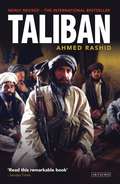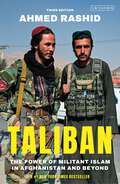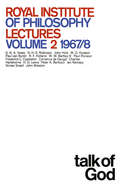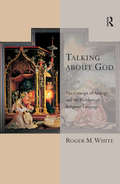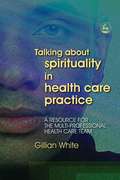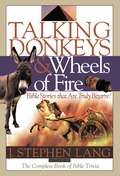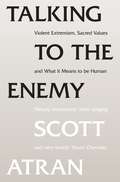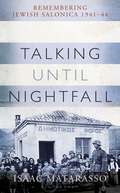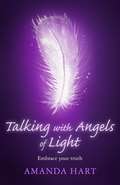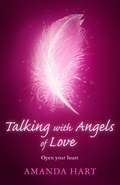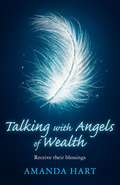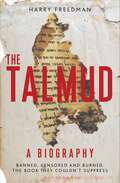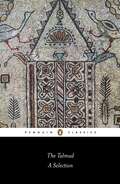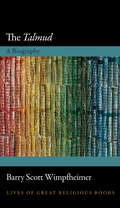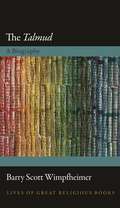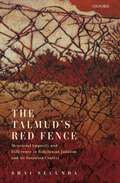- Table View
- List View
Taliban: The Power of Militant Islam in Afghanistan and Beyond (Basic Ser. #Vol. 59)
by Ahmed RashidThe American bombing of terrorist bases in Afghanistan under the protection of the Islamic fundamentalist Taliban movement has brought the Taliban into sharp focus as the most radical and extreme Islamic movement in the world today. Little is known about the Taliban because of the deep secrecy that surrounds their political movement, their leaders and their aims.The geo-strategic implications of the Taliban are already creating severe instability in Russia, Iran and the five Central Asian republics where the Taliban have become a major player in the new Great Game, as Western countries and companies compete to build oil and gas pipelines from Central Asia to Western and Asian markets.The Taliban's implementation of their extreme interpretation of Islam poses new challenges to the Muslim world and the West's understanding of radical Islam in the post-Cold War era.'This is an impressive and eminently readable analysis of the Taliban movement, of its background and impact on Afghanistan, and of the wider regional and geopolitical implications of the Taliban's advent to power. The author himself is especially well placed to provide this account, having covered Afghanistan itself for two decades and having direct access to policy-makers in Pakistan, Iran and Central Asia. This is not the first book to be written on the Taliban, or Afghanistan in the 1990s. It promises, however, to be by far the strongest. It would be hard to see how anyone could rival the range and details of this account: this bids well to be the leading book on the subject.' - Professor Fred Halliday, London School of EconomicsTaliban: Islam, Oil and the New Great Game was runner-up in the prestigious annual British-Kuwait Friendship Society Prize, administered by the British Society for Middle Eastern Studies.
Taliban: The Power of Militant Islam in Afghanistan and Beyond
by Ahmed RashidA #1 NEW YORK TIMES BESTSELLER Following the U.S-Taliban peace deal of February 2020 - and the U.S's promised withdrawal from Afghanistan - the Taliban began terrorizing Afghan security forces, civilians and the government in Kabul. By August 2021, the group had seized control of the entire country.Taliban is a New York Times bestseller by the award-winning journalist Ahmed Rashid. Now considered a modern classic, the book provides rare insight into the history of the Taliban, their political movement, their leaders and their aims. This authoritative account is renowned for being able to explain one of the world's most extreme organizations from their inception in northern Pakistan in the early 1990s to their rise to power. In doing so, Rashid closely details their impact on Afghanistan, the Middle East and Central Asia, and how and why the Taliban spread, including their relationship with both Al-Qaeda and the U.S. The book has sold more than 1.5 million copies worldwide and has been translated into over 40 languages. This third edition marks twenty years since the U.S. invaded Afghanistan and the author adds a new introduction to reflect on how the group regained their strength, the humanitarian crisis, and what Taliban rule is likely to mean for the region and the world.
Taliban: The Power of Militant Islam in Afghanistan and Beyond
by Ahmed RashidA #1 NEW YORK TIMES BESTSELLER Following the U.S-Taliban peace deal of February 2020 - and the U.S's promised withdrawal from Afghanistan - the Taliban began terrorizing Afghan security forces, civilians and the government in Kabul. By August 2021, the group had seized control of the entire country.Taliban is a New York Times bestseller by the award-winning journalist Ahmed Rashid. Now considered a modern classic, the book provides rare insight into the history of the Taliban, their political movement, their leaders and their aims. This authoritative account is renowned for being able to explain one of the world's most extreme organizations from their inception in northern Pakistan in the early 1990s to their rise to power. In doing so, Rashid closely details their impact on Afghanistan, the Middle East and Central Asia, and how and why the Taliban spread, including their relationship with both Al-Qaeda and the U.S. The book has sold more than 1.5 million copies worldwide and has been translated into over 40 languages. This third edition marks twenty years since the U.S. invaded Afghanistan and the author adds a new introduction to reflect on how the group regained their strength, the humanitarian crisis, and what Taliban rule is likely to mean for the region and the world.
The Taliban and the Crisis of Afghanistan
by Robert D. Crews and Amin TarziThe Taliban remain one of the most elusive forces in modern history. A ragtag collection of clerics and madrasa students, this obscure movement emerged out of the rubble of the Cold War to shock the world with their draconian Islamic order. The Taliban refused to surrender their vision even when confronted by the United States after September 11, 2001. Reinventing themselves as part of a broad insurgency that destabilized Afghanistan, they pledged to drive out the Americans, NATO, and their allies and restore their "Islamic Emirate." The Taliban and the Crisis of Afghanistan explores the paradox at the center of this challenging phenomenon: how has a seemingly anachronistic band of religious zealots managed to retain a tenacious foothold in the struggle for Afghanistan's future? Grounding their analysis in a deep understanding of the country's past, leading scholars of Afghan history, politics, society, and culture show how the Taliban was less an attempt to revive a medieval theocracy than a dynamic, complex, and adaptive force rooted in the history of Afghanistan and shaped by modern international politics. Shunning journalistic accounts of its conspiratorial origins, the essays investigate broader questions relating to the character of the Taliban, its evolution over time, and its capacity to affect the future of the region. Offering an invaluable guide to "what went wrong" with the American reconstruction project in Afghanistan, this book accounts for the persistence of a powerful and enigmatic movement while simultaneously mapping Afghanistan's enduring political crisis.
Talking about God: The Concept of Analogy and the Problem of Religious Language (Transcending Boundaries in Philosophy and Theology)
by Roger M. WhiteA fundamental question for theology is the question how we are to understand the claims that we make about God. The only language we can understand is the language we use to talk about human beings and their environment. How can we use that language to talk about God while respecting the infinite difference between God and humanity? The traditional answer has been to appeal to the concept of analogy. However, that appeal has been interpreted in widely different ways. This book aims to clarify the question and this answer by an analysis of the concept. It begins with an exploration of the way the concept was evolved by Aristotle out of Greek mathematics as a technique for comparing "things that were remote"; followed by a critical examination of three very different classical accounts of the way religious language works: those of Thomas Aquinas, Immanuel Kant and Karl Barth. The book finally investigates the way in which analogy could be applied to answer the question initially posed - how is it possible to use human language to talk about God. This is a question of fundamental significance for the whole of religion and theology, concerning as it does our whole understanding of what we mean when we talk about God.
Talking about God: The Concept of Analogy and the Problem of Religious Language (Transcending Boundaries in Philosophy and Theology)
by Roger M. WhiteA fundamental question for theology is the question how we are to understand the claims that we make about God. The only language we can understand is the language we use to talk about human beings and their environment. How can we use that language to talk about God while respecting the infinite difference between God and humanity? The traditional answer has been to appeal to the concept of analogy. However, that appeal has been interpreted in widely different ways. This book aims to clarify the question and this answer by an analysis of the concept. It begins with an exploration of the way the concept was evolved by Aristotle out of Greek mathematics as a technique for comparing "things that were remote"; followed by a critical examination of three very different classical accounts of the way religious language works: those of Thomas Aquinas, Immanuel Kant and Karl Barth. The book finally investigates the way in which analogy could be applied to answer the question initially posed - how is it possible to use human language to talk about God. This is a question of fundamental significance for the whole of religion and theology, concerning as it does our whole understanding of what we mean when we talk about God.
Talking About Spirituality in Health Care Practice: A Resource for the Multi-Professional Health Care Team
by Gillian WhiteHealth care professionals who endeavour to work holistically face a number of questions about spirituality. What is meant by `spirituality' as opposed to `religion'? What is its specific relevance to health care practice? This accessible book provides answers to these questions and offers a model for personal and professional development. Gillian White sets out a framework within which health care professionals can discuss spirituality and equip themselves to respond appropriately to the spiritual concerns of their patient in daily practice. She draws on her experience of sharing and discussing spirituality and spiritual care with other health care professionals and proposes that multi-professional health care teams should talk about spirituality in challenging but safe environments to develop shared understanding of it, and to increase their confidence about integrating spiritual care into their daily practise. This text is a useful contribution to the multi-disciplinary, whole-person approach in health care and will be of interest to all health care professionals, nursing staff and students in these fields.
Talking About Spirituality in Health Care Practice: A Resource for the Multi-Professional Health Care Team (PDF)
by Gillian WhiteHealth care professionals who endeavour to work holistically face a number of questions about spirituality. What is meant by `spirituality' as opposed to `religion'? What is its specific relevance to health care practice? This accessible book provides answers to these questions and offers a model for personal and professional development. Gillian White sets out a framework within which health care professionals can discuss spirituality and equip themselves to respond appropriately to the spiritual concerns of their patient in daily practice. She draws on her experience of sharing and discussing spirituality and spiritual care with other health care professionals and proposes that multi-professional health care teams should talk about spirituality in challenging but safe environments to develop shared understanding of it, and to increase their confidence about integrating spiritual care into their daily practise. This text is a useful contribution to the multi-disciplinary, whole-person approach in health care and will be of interest to all health care professionals, nursing staff and students in these fields.
Talking Donkeys and Wheels of Fire: Bible Stories That are Truly Bizarre
by J. Stephen LangBible trivia expert J. Stephen Lang pulls together some wild and wacky biblical tales. Think the Bible is boring? Think again. These tales will both entertain and enlighten the reader, and engender a desire to read the Bible in search of more.
Talking to the Enemy: Violent Extremism, Sacred Values, and What it Means to Be Human
by Scott AtranTalking to the Enemy is an intellectually and personally courageous exploration of one of the most contentious issues of modern times. Scott Atran has spent years talking to terrorists - from Gaza and Afghanistan, to Indonesia and Europe - in order to help us understand and mitigate the rise of religious violence. Here he argues persuasively that we need to consider terrorists' close relationships, with family and friends, as much as the causes they espouse, and delivers a fascinating journey into the mindsets of radicalised people in the twenty-first century. Along the way, he also provides deep insights into the history of all religions, and into their evolutionary origins. He shows us, above all, how we have come to be human.More than any other book, Talking to the Enemy invites us to empathise; it is itself the best possible example of how to do it.
Talking to the Other: Jewish Interfaith Dialogue with Christians and Muslims
by Jonathan MagonetSuicide killings - both in American and Israel - have focused world attention on international terrorism and the need both to understand its causes and combat it through all possible means. But the involvement of people claiming that their Islamic faith justified murderous suicide action has intensified demonisation of Islam in the west and in turn highlighted the need to understand and relate to Muslims in all their diversity. For a rabbi, confronted on a daily basis with the conflict between Israelis and Palestinians, the importance of a dialogue between Jews and Muslims is of obvious importance. Because Jews and Muslims share the experience of being minority religious communities in Europe, they have parallel experiences and needs. Moreover, both have to address the impact of the Middle East conflict on their own communities. Rabbi Jonathan Magonet has long been engaged in such interfaith dialogue. For over thirty years he has organised the annual Jewish-Christian-Muslim student conference in Basle, and has lectured on these themes and participated himself in interfaith conferences all over the world. In this book he explores the issues that arise in such an encounter, the traps that so easily hinder relationships, and the historical and theological problems to be confronted once a basis of trust has been established. As well as examining specific areas that need to be addressed in the Jewish encounter with Christians and Muslims, he challenges the Jewish community to broaden its commitment to interfaith dialogue in a complex and rapidly changing world.
Talking Until Nightfall: Remembering Jewish Salonica, 1941–44
by Isaac Matarasso'Whoever listens to a witness, becomes a witness.' – Elie WieselWhen Nazi occupiers arrived in Greece in 1941, it was the beginning of a horror that would reverberate through generations. In the city of Salonica (Thessaloniki), almost 50,000 Jews were sent to Nazi concentration camps during the war, and only 2,000 returned. A Jewish doctor named Isaac Matarasso and his son escaped imprisonment and torture at the hands of the Nazis and joined the resistance. After the city's liberation they returned to rebuild Salonica and, along with the other survivors, to grapple with the near-total destruction of their community. Isaac was a witness to his Jewish community's devastation, and the tangled aftermath of grief, guilt and grace as survivors returned home. Talking Until Nightfall presents his account of the tragedy and his moving tribute to the living and the dead. His story is woven together with his son Robert's memories of being a frightened teenager spared by a twist of fate, with an afterword by his grandson Francois that looks back on the survivors' stories and his family's place in history. This slim, wrenching account of loss, survival, and the strength of the human spirit will captivate readers and ensure the Jews of Salonica are never forgotten.
Talking Until Nightfall: Remembering Jewish Salonica, 1941–44
by Isaac Matarasso'Whoever listens to a witness, becomes a witness.' – Elie WieselWhen Nazi occupiers arrived in Greece in 1941, it was the beginning of a horror that would reverberate through generations. In the city of Salonica (Thessaloniki), almost 50,000 Jews were sent to Nazi concentration camps during the war, and only 2,000 returned. A Jewish doctor named Isaac Matarasso and his son escaped imprisonment and torture at the hands of the Nazis and joined the resistance. After the city's liberation they returned to rebuild Salonica and, along with the other survivors, to grapple with the near-total destruction of their community. Isaac was a witness to his Jewish community's devastation, and the tangled aftermath of grief, guilt and grace as survivors returned home. Talking Until Nightfall presents his account of the tragedy and his moving tribute to the living and the dead. His story is woven together with his son Robert's memories of being a frightened teenager spared by a twist of fate, with an afterword by his grandson Francois that looks back on the survivors' stories and his family's place in history. This slim, wrenching account of loss, survival, and the strength of the human spirit will captivate readers and ensure the Jews of Salonica are never forgotten.
Talking with Angels of Light: Embrace your Truth
by Amanda HartAmanda Hart was rescued by guardian angels as a child and from thence on they became a beacon of hope throughout her turbulent journey into womanhood. The illuminating conversations she has with her angels remain an important aspect of her everyday life, bringing her continual support and spiritual fulfilment. She now dedicates her life to helping others connect with their own angels, helping them to find deeper meaning and happiness in their lives.Talking with Angels of Light is a book for you if the values and beliefs that have guided your life so far are based on destructive relationships, negative emotions or traumatic experiences from your past. Amanda Hart will teach you how to open your heart and allow your angels to save you from darkness and bring you into the light where you belong.The book includes meditations to connect with your angels of light, space to record the blessings they send you and real accounts of angelic assistance granted to Amanda and her clients over the years. There are also practical exercises, Amanda calls 'Your Lightbulb Moments' that will make you more aware of the brilliance in the world around you. Soon you will emerge from the shadows of despair and shine like the purest light in the universe, glowing from the inside out.
Talking with Angels of Love: Open your Heart
by Amanda HartThere was once a time in Amanda Hart's life when she did not know how to be secure in her own worth, was a stranger to self-love and found herself constantly trapped in a cycle of toxic relationships, coercive control and an overwhelming sense of lonliness. Somehow she summoned enough faith to form an astonishing connection with her guardian angels, which became the only remedy for emotional trauma she experienced from early childhood into adulthood.Amanda's angels taught her that we are all worthy of an authentic, non-judgemental love. Now she devotes her life to helping others open their hearts and receive angelic assistance. Talking with Angels of Love will show you how to accept your circumstances, love the skin you are in and recognise the difference between healthy love and toxic love. Filled with practical exercises, meditations to channel your angels' love, pages to record their loving messages and touching real-life stories about the healing power of love, this book will soothe your soul and help you to trust the goodness in others again. Amanda believes that if you open your heart to the angels their love is everlasting, and you will never be lonely again.
Talking with Angels of Wealth: Receive their blessings
by Amanda HartAmanda Hart was rescued by guardian angels as a child and from thence on they became a beacon of hope throughout her turbulent journey into womanhood. The illuminating conversations she has with her angels remain an important aspect of her everyday life, bringing her continual support and spiritual fulfillment. She now dedicates her life to helping others connect with their own angels, helping them to find deeper meaning and happiness in their lives.From the author of Talking with Angels of Light comes another empowering and life-altering book. Amanda Hart's connection with her guardian angels has taught her how to unlock her power, purpose and voice when it comes to financial matters. By following practical exercises, meditations and reading real-life anecdotes this book will guide you towards a healthy, revitalised relationship with money.
The Talmud: A Biography - Banned, Censored and Burned, The Book They Couldn't Suppress
by Harry FreedmanContaining nearly two million words in 37 volumes, the Talmud covers topics as diverse as law, faith, medicine, magic, ethics, sex, humour and prayer. It is a highly complex, profoundly logical and frequently impenetrable work with a history like no other. In its 1500 year history the Talmud has been banned, censored and burned, dissected by scholars and rabbis, probed by philosophers, poets, republicans and kings. In The Talmud – A Biography, Jewish scholar Harry Freedman tells the engrossing story of an ancient classic, the legal and mystical pillar of Judaism and recounts the story of a book which, in many ways, parallels the history of the Jewish people. From its origins as a record of discussions amongst scholars in towns and villages close to modern-day Baghdad, Freedman traces the spiraling paths of the Jewish diaspora and explores the story of the Talmud's early origins in Babylon, its role during the Enlightenment and its influence over traditional Judaism. A compelling fusion of law, storytelling and spirituality, the Talmud's story is a fascinating insight into the history of Judaism and Harry Freedman's The Talmud – A Biography is a remarkable account of one of the most important cultural, historical and religious works of our time.
The Talmud: A Selection
by Norman SolomonThe Talmud is one of the most significant religious texts in the world, second only to the Bible in its importance to Judaism. As the Bible is the word of God, The Talmud applies that word to the lives of its followers. In a range of styles including commentary, parables, proverbs and anecdotes, it provides guidance on all aspects of everyday life from ownership to commerce to relationships. This selection of its most illuminating passages makes accessible the centuries of Jewish thought within The Talmud.Norman Solomon's clear translation from the Bavli (Babylonian) Talmud is accompanied by an introduction on its arrangement, social and historical background, reception and authors. This edition also includes appendixes of background information, a glossary, time line, maps and indexes.
The "Talmud": A Biography (Lives of Great Religious Books)
by Barry Scott WimpfheimerThe life and times of an enduring work of Jewish spiritualityThe Babylonian Talmud, a postbiblical Jewish text that is part scripture and part commentary, is an unlikely bestseller. Written in a hybrid of Hebrew and Aramaic, it is often ambiguous to the point of incomprehension, and its subject matter reflects a narrow scholasticism that should hardly have broad appeal. Yet the Talmud has remained in print for centuries and is more popular today than ever. Barry Scott Wimpfheimer tells the remarkable story of this ancient Jewish book and explains why it has endured for almost two millennia.Providing a concise biography of this quintessential work of rabbinic Judaism, Wimpfheimer takes readers from the Talmud's prehistory in biblical and second-temple Judaism to its present-day use as a source of religious ideology, a model of different modes of rationality, and a totem of cultural identity. He describes the book's origins and structure, its centrality to Jewish law, its mixed reception history, and its golden renaissance in modernity. He explains why reading the Talmud can feel like being swept up in a river or lost in a maze, and why the Talmud has come to be venerated--but also excoriated and maligned—in the centuries since it first appeared.An incomparable introduction to a work of literature that has lived a full and varied life, this accessible book shows why the Talmud is at once a received source of traditional teachings, a touchstone of cultural authority, and a powerful symbol of Jewishness for both supporters and critics.
The "Talmud": A Biography (Lives of Great Religious Books)
by Barry Scott WimpfheimerThe life and times of an enduring work of Jewish spiritualityThe Babylonian Talmud, a postbiblical Jewish text that is part scripture and part commentary, is an unlikely bestseller. Written in a hybrid of Hebrew and Aramaic, it is often ambiguous to the point of incomprehension, and its subject matter reflects a narrow scholasticism that should hardly have broad appeal. Yet the Talmud has remained in print for centuries and is more popular today than ever. Barry Scott Wimpfheimer tells the remarkable story of this ancient Jewish book and explains why it has endured for almost two millennia.Providing a concise biography of this quintessential work of rabbinic Judaism, Wimpfheimer takes readers from the Talmud's prehistory in biblical and second-temple Judaism to its present-day use as a source of religious ideology, a model of different modes of rationality, and a totem of cultural identity. He describes the book's origins and structure, its centrality to Jewish law, its mixed reception history, and its golden renaissance in modernity. He explains why reading the Talmud can feel like being swept up in a river or lost in a maze, and why the Talmud has come to be venerated--but also excoriated and maligned—in the centuries since it first appeared.An incomparable introduction to a work of literature that has lived a full and varied life, this accessible book shows why the Talmud is at once a received source of traditional teachings, a touchstone of cultural authority, and a powerful symbol of Jewishness for both supporters and critics.
The "Talmud": A Biography (Lives of Great Religious Books)
by Barry Scott WimpfheimerThe life and times of an enduring work of Jewish spiritualityThe Babylonian Talmud, a postbiblical Jewish text that is part scripture and part commentary, is an unlikely bestseller. Written in a hybrid of Hebrew and Aramaic, it is often ambiguous to the point of incomprehension, and its subject matter reflects a narrow scholasticism that should hardly have broad appeal. Yet the Talmud has remained in print for centuries and is more popular today than ever. Barry Scott Wimpfheimer tells the remarkable story of this ancient Jewish book and explains why it has endured for almost two millennia.Providing a concise biography of this quintessential work of rabbinic Judaism, Wimpfheimer takes readers from the Talmud's prehistory in biblical and second-temple Judaism to its present-day use as a source of religious ideology, a model of different modes of rationality, and a totem of cultural identity. He describes the book's origins and structure, its centrality to Jewish law, its mixed reception history, and its golden renaissance in modernity. He explains why reading the Talmud can feel like being swept up in a river or lost in a maze, and why the Talmud has come to be venerated--but also excoriated and maligned—in the centuries since it first appeared.An incomparable introduction to a work of literature that has lived a full and varied life, this accessible book shows why the Talmud is at once a received source of traditional teachings, a touchstone of cultural authority, and a powerful symbol of Jewishness for both supporters and critics.
The Talmud: A Biography (Lives of Great Religious Books #28)
by Barry Scott WimpfheimerThe life and times of an enduring work of Jewish spiritualityThe Babylonian Talmud, a postbiblical Jewish text that is part scripture and part commentary, is an unlikely bestseller. Written in a hybrid of Hebrew and Aramaic, it is often ambiguous to the point of incomprehension, and its subject matter reflects a narrow scholasticism that should hardly have broad appeal. Yet the Talmud has remained in print for centuries and is more popular today than ever. Barry Scott Wimpfheimer tells the remarkable story of this ancient Jewish book and explains why it has endured for almost two millennia.Providing a concise biography of this quintessential work of rabbinic Judaism, Wimpfheimer takes readers from the Talmud's prehistory in biblical and second-temple Judaism to its present-day use as a source of religious ideology, a model of different modes of rationality, and a totem of cultural identity. He describes the book's origins and structure, its centrality to Jewish law, its mixed reception history, and its golden renaissance in modernity. He explains why reading the Talmud can feel like being swept up in a river or lost in a maze, and why the Talmud has come to be venerated--but also excoriated and maligned—in the centuries since it first appeared.An incomparable introduction to a work of literature that has lived a full and varied life, this accessible book shows why the Talmud is at once a received source of traditional teachings, a touchstone of cultural authority, and a powerful symbol of Jewishness for both supporters and critics.
The Talmud – A Biography: Banned, censored and burned. The book they couldn't suppress
by Harry FreedmanContaining nearly two million words in 37 volumes, the Talmud covers topics as diverse as law, faith, medicine, magic, ethics, sex, humour and prayer. It is a highly complex, profoundly logical and frequently impenetrable work with a history like no other. In its 1500 year history the Talmud has been banned, censored and burned, dissected by scholars and rabbis, probed by philosophers, poets, republicans and kings. In The Talmud – A Biography, Jewish scholar Harry Freedman tells the engrossing story of an ancient classic, the legal and mystical pillar of Judaism and recounts the story of a book which, in many ways, parallels the history of the Jewish people. From its origins as a record of discussions amongst scholars in towns and villages close to modern-day Baghdad, Freedman traces the spiraling paths of the Jewish diaspora and explores the story of the Talmud's early origins in Babylon, its role during the Enlightenment and its influence over traditional Judaism. A compelling fusion of law, storytelling and spirituality, the Talmud's story is a fascinating insight into the history of Judaism and Harry Freedman's The Talmud – A Biography is a remarkable account of one of the most important cultural, historical and religious works of our time.
The Talmud's Red Fence: Menstrual Impurity And Difference In Babylonian Judaism And Its Sasanian Context
by Shai SecundaThe Talmud's Red Fence explores how rituals and beliefs concerning menstruation in the Babylonian Talmud and neighboring Sasanian religious texts were animated by difference and differentiation. It argues that the practice and development of menstrual rituals in Babylonian Judaism was a product of the religious terrain of the Sasanian Empire, where groups like Syriac Christians, Mandaeans, Zoroastrians, and Jews defined themselves in part based on how they approached menstrual impurity. It demonstrates that menstruation was highly charged in Babylonian Judaism and Sasanian Zoroastrian, where menstrual discharge was conceived of as highly productive female seed yet at the same time as stemming from either primordial sin (Eve eating from the tree) or evil (Ahrimen's kiss). It argues that competition between rabbis and Zoroastrians concerning menstrual purity put pressure on the Talmudic system, for instance in the unusual development of an expert diagnostic system of discharges. It shows how Babylonian rabbis seriously considered removing women from the home during the menstrual period, as Mandaeans and Zoroastrians did, yet in the end deemed this possibility too "heretical." Finally, it examines three cases of Babylonian Jewish women initiating menstrual practices that carved out autonomous female space. One of these, the extension of menstrual impurity beyond the biblically mandated seven days, is paralleled in both Zoroastrian Middle Persian and Mandaic texts. Ultimately, Talmudic menstrual purity is shown to be driven by difference in its binary structure of pure and impure; in gendered terms; on a social axis between Jews and Sasanian non-Jewish communities; and textually in the way the Palestinian and Babylonian Talmuds took shape in late antiquity.
